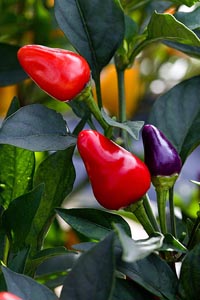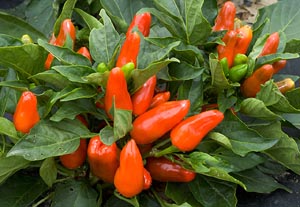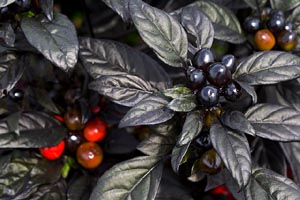
Peppers don’t have to be just green and bell shaped and relegated to the supermarket shelf or home garden plot. This genus of plants has the genetic potential to provide a wide array of possibilities for the kitchen and the ornamental garden and sometimes both at once.
Research on peppers from the USDA’s Agricultural Research Service (ARS) is being featured from June to November in an exhibit called “A Pepper for Every Pot” at the U.S. Botanic Gardens in Washington, D.C. This exhibit explores the diversity of peppers, including recently introduced varieties, and celebrates peppers’ beauty, flavors and nutritional benefits.

Pod-type peppers (Capsicum spp.) have long been an important agricultural crop in subtropical regions, and many different varieties can be found in cuisines around the world. Native to the Western hemisphere, they figured strongly in the Aztec, Mayan and Incan cultures, second only in importance to maize. Nowadays, however, peppers are just as likely to show up in flower gardens as in vegetable gardens. With rich colors and delightful shapes, they have become a commercially successful ornamental crop. A Pepper for Every Pot explores the diversity of peppers, including many recently introduced varieties, and celebrates peppers’ beauty, flavors, and nutritional benefits.

ARS scientists were first drawn to peppers because so much genetic diversity exists in the Capsicum genus for fruit and leaf shape, size, and color as well as plant habit. As a result, ARS has bred a number of new peppers that are — or soon will be — available. ‘Tangerine Dream’ is a sweet, edible ornamental pepper that produces small orange banana-shaped fruit on a prostrate plant. It makes a great ground cover, shading out weeds with black leaves, purple flowers, and colorful fruit. Another new pepper, developed to celebrate Halloween, has black foliage and orange pumpkin-shaped fruit! ‘Black Pearl’, an All-America Selections award winner, offers gardeners a new dark choice: black leaves and shiny black fruit that ripen to bright scarlet. Both varieties are commercially available.
And for the cook, the peppers have a hot bite. With today’s smaller urban gardens, peppers such as ‘Black Pearl’ that do double duty as both ornamental and culinary plants fill a new niche.

Besides being both pretty and tasty, peppers have important nutrients. For example, ARS scientists are researching the biochemistry of the anthocyanins that give ‘Black Pearl’ fruits their deep black color and protection against strong ultraviolet sunlight, and they have found that when consumed by humans, these anthocyanins function as antioxidants, providing protection from some diseases. Other improvements being researched include shorter periods from seed germination to harvest, sturdier stems, heat and drought tolerance, and excellent keeping (storage) quality. Future breeding could allow scientists to produce plants with different combinations of fruit color, leaf color, form, sturdiness, and nutritional qualities.
– adapted from a USDA-ARS news release by Kim Kaplan, June 28, 2007 at www.ars.usda.gov/is/pr/2007/070628.htm
Additional Information
- Twice as Nice Breeding Versatile Vegetables – USDA ARS article on pepper breeding
- U.S. Botanic Gardens in Washington, D.C.





 Marigolds
Marigolds Create a Butterfly Garden
Create a Butterfly Garden Plant Flowers to Encourage Beneficial Insects
Plant Flowers to Encourage Beneficial Insects Forcing Bulbs
Forcing Bulbs


